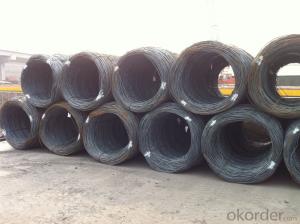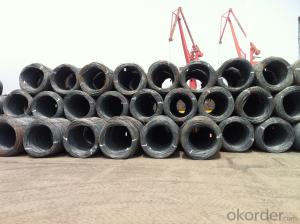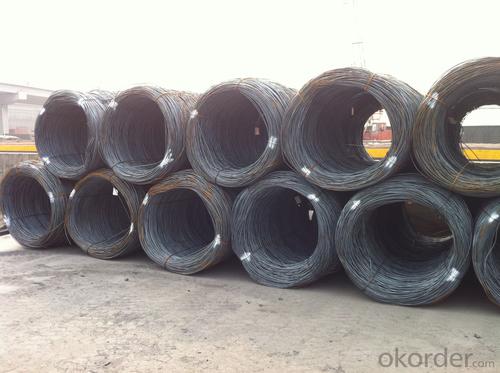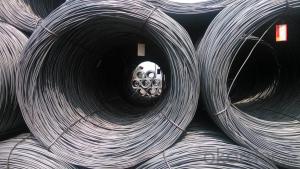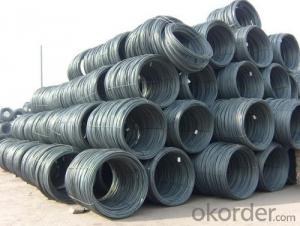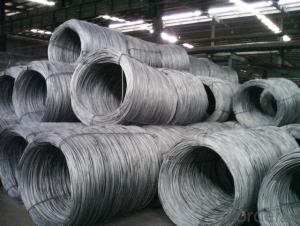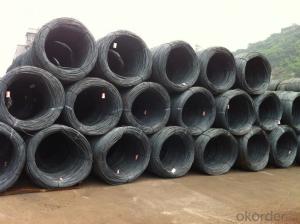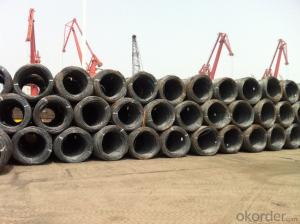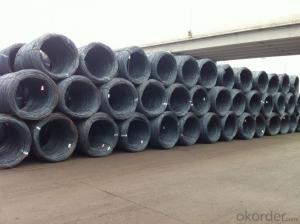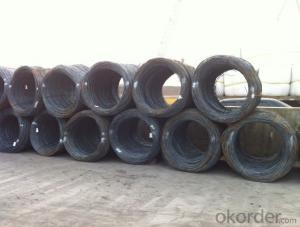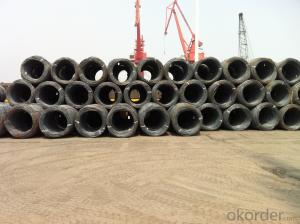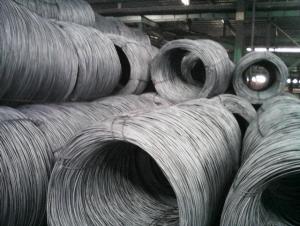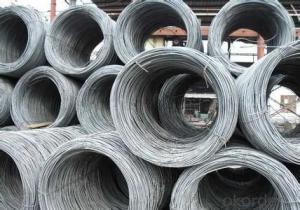Wire rod SAE1006-1008 with Highest Quality and Lowest Price
- Loading Port:
- Tianjin
- Payment Terms:
- TT OR LC
- Min Order Qty:
- 25 m.t
- Supply Capability:
- 20000 m.t/month
OKorder Service Pledge
OKorder Financial Service
You Might Also Like
Specification
OKorder is offering Hot Rolled Carbon Steel Wire Rod 5.5mm with High Quality at great prices with worldwide shipping. Our supplier is a world-class manufacturer of steel, with our products utilized the world over. OKorder annually supplies products to European, North American and Asian markets. We provide quotations within 24 hours of receiving an inquiry and guarantee competitive prices.
Product Applications:
Hot Rolled Carbon Steel Wire Rod 5.5mm with High Quality is widely used in construction and manufacturing. Carbon steel wire rod is mainly used for reinforcement of reinforced concrete and welded structure or reprocessed (roberts , nail, etc.) materials, especially used to produce wire drawing, welding electrode, nails, spring, electronic, precise machinery parts and so on.
Product Advantages:
OKorder's Hot Rolled Carbon Steel Wire Rod are durable, strong.packed and suitable for wire mesh,nail manufacture and construction
Main Product Features:
· Premium quality
· Prompt delivery & seaworthy packing (30 days after receiving deposit)
· Can be recycled and reused
· Mill test certification
· Professional Service
· Competitive pricing
Product Specifications:
Manufacture: Hot rolled
Grade: SAE1006 SAE1008 SAE1010 SAE1012 SAE1016 SAE1018
Certificates: ISO, SGS, BV, CIQ
Weight per Coil:2-2.05tons
Packaging: Export packing, packed by coil
Grade | Chemical Composition (%) | |||||
C | Mn | S | P | Si | B | |
SAE1006B | 0.03~O.07 | 0.32max | 0.045max | 0.040max | 0.30max | 0.0008min |
Mechanical properties | ||||||
Yield strength(N/mm2) | Tensile strength(N/mm2) | Elongation (%) | ||||
250-280 | 350-380 | ≥32 | ||||
Grade | Chemical Composition (%) | |||||
C | Mn | S | P | Si | B | |
SAE1008B | 0.10max | 0.3~0.50 | 0.050max | 0.040 max | 0.15max | 0.0008 min |
Mechanical properties | ||||||
Yield strength(N/mm2) | Tensile strength(N/mm2) | Elongation (%) | ||||
≥195 | 315-430 | ≥30 | ||||
FAQ:
Q1: Why buy Materials & Equipment from OKorder.com?
A1: All products offered byOKorder.com are carefully selected from China's most reliable manufacturing enterprises. Through its ISO certifications, OKorder.com adheres to the highest standards and a commitment to supply chain safety and customer satisfaction.
Q2: How do we guarantee the quality of our products?
A2: We have established an advanced quality management system which conducts strict quality tests at every step, from raw materials to the final product. At the same time, we provide extensive follow-up service assurances as required.
Q3:What's your payment terms ?
A3:Mostly,we collect the money by T/T and LC at sight . We also accept time LC at 90/120 days sight.
Image:
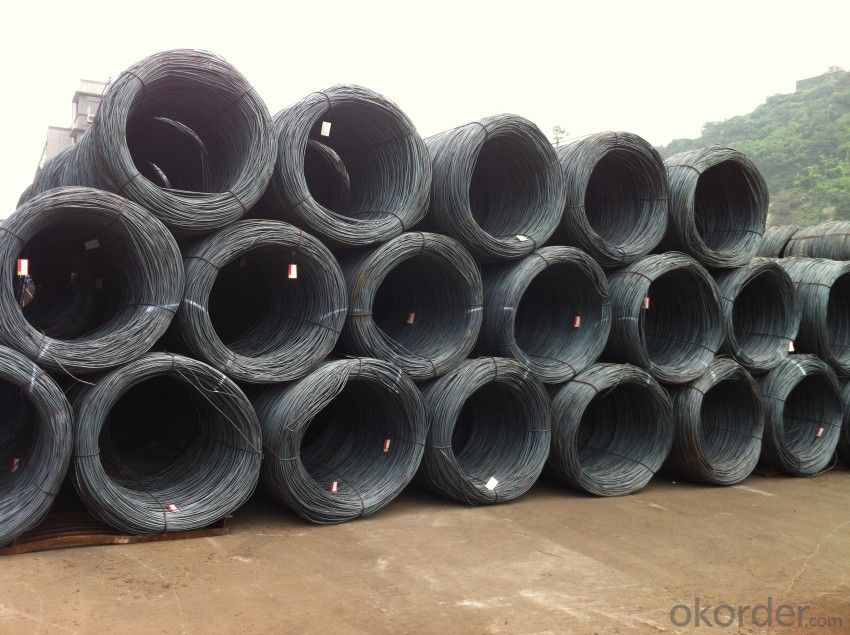
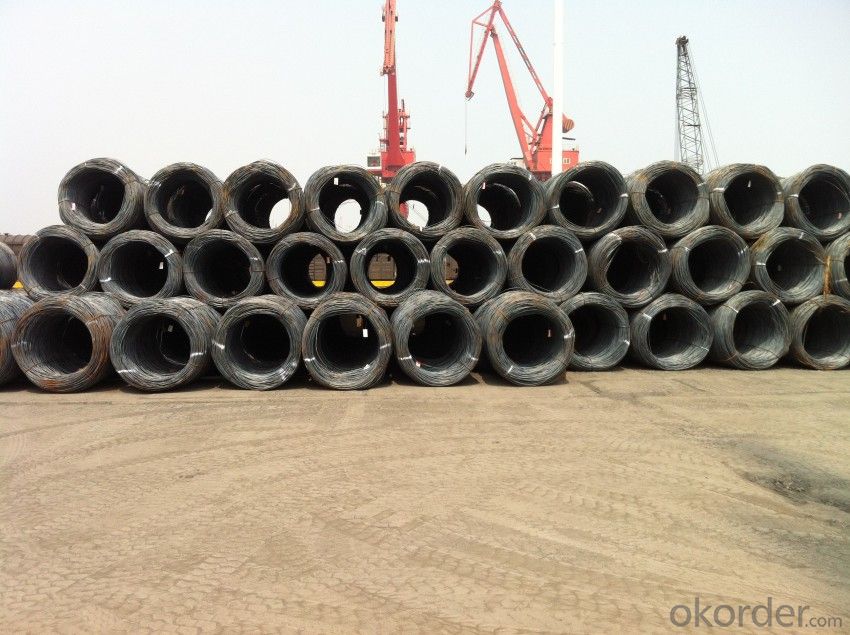
- Q: What are the factors that affect the corrosion resistance of steel wire rod?
- The corrosion resistance of steel wire rod can be affected by multiple factors. Firstly, the composition of the steel plays a significant role. The addition of different alloying elements, such as chromium and nickel in stainless steel, can enhance its resistance to corrosion. Secondly, the surface condition of the steel wire rod is crucial. A rough or impure surface can provide sites for corrosion initiation, while a smooth and clean surface can inhibit corrosion. Additionally, environmental conditions have a great impact on the corrosion resistance. Factors like humidity, temperature, and the presence of corrosive substances like acids or salts can accelerate corrosion. Exposure to marine environments or industrial atmospheres with high levels of pollutants can also increase the likelihood of corrosion. Moreover, the application of protective coatings can greatly enhance the corrosion resistance of steel wire rod. Coatings such as zinc or epoxy act as a barrier, preventing corrosive agents from reaching the steel's surface. Lastly, mechanical stress or strain can influence the corrosion resistance. Stress concentrations or deformation can create microcracks or expose vulnerable areas, leading to localized corrosion. In conclusion, factors like alloy composition, surface condition, environmental conditions, protective coatings, and mechanical stress all play a role in the corrosion resistance of steel wire rod. It is essential to understand and control these factors to ensure the longevity and reliability of steel wire rod in various applications.
- Q: What are the standard surface roughness requirements for steel wire rod?
- The standard surface roughness requirements for steel wire rod typically vary depending on the specific industry and application. However, in general, the surface roughness for steel wire rod is usually specified to be within a certain range, such as Ra 0.8-1.6 µm (micrometers) or Ra 32-63 µin (microinches). These requirements ensure that the surface of the wire rod is smooth enough to meet the desired performance and functionality while also allowing for efficient processing and handling.
- Q: How is steel wire rod used in the production of cold-formed steel sections?
- Steel wire rod is used in the production of cold-formed steel sections as it serves as the primary raw material for these sections. The wire rod is typically formed and shaped through a cold-forming process, where it is bent, twisted, or rolled into the desired shape and dimensions. This allows manufacturers to produce a wide range of cold-formed steel sections, such as channels, angles, and beams, which are commonly used in construction, automotive, and manufacturing industries. The high strength and durability of steel wire rod make it an ideal material for cold-formed steel sections, ensuring structural integrity and reliability in various applications.
- Q: How is steel wire rod classified based on its diameter?
- Steel wire rod is classified based on its diameter into different size ranges, commonly referred to as gauges or wire sizes. These sizes can vary depending on the industry or manufacturing standards being followed.
- Q: How are steel wire rods stored to prevent corrosion?
- Steel wire rods are typically stored in a way that minimizes exposure to moisture and air, which are the primary causes of corrosion. To prevent corrosion, the rods are usually stored in a dry and well-ventilated area, away from direct contact with the ground and any potential sources of moisture such as water pipes or damp walls. They are often stored on pallets or racks, allowing for proper airflow and preventing contact with any surface that may contain water or excessive humidity. Additionally, steel wire rods are often coated with a protective layer, such as oil or a rust preventive compound, to further safeguard against corrosion during storage. Regular inspections and maintenance are also crucial to ensure that the storage conditions remain optimal and any signs of corrosion are promptly addressed.
- Q: How are steel wire rods used in the manufacturing of strings for musical instruments?
- Steel wire rods are an essential component in the manufacturing of strings for musical instruments. These rods are primarily used as the core material for creating the inner structure of strings, providing them with strength, durability, and the ability to withstand tension. To manufacture musical instrument strings, steel wire rods undergo a series of processes. First, they are carefully selected based on their quality and desired characteristics, such as flexibility and tensile strength. These rods are then subjected to a process called drawing, where they are pulled through a series of dies to reduce their diameter and increase their length. After drawing, the steel wire rods are often further processed through several steps to enhance their performance. These steps may include annealing, which involves heating the rods to a specific temperature and then slowly cooling them to improve their flexibility and eliminate any internal stresses. Additionally, the rods may undergo surface treatments such as electroplating or coating to prevent corrosion and improve their playability. Once the steel wire rods have been processed, they are ready to be transformed into strings. The rods are typically wound around a core material, such as nylon or gut, to create the desired thickness and tension for each string. The winding process involves tightly wrapping the steel wire around the core material, ensuring that it remains in place and provides the necessary strength and stability. The use of steel wire rods in the manufacturing of strings for musical instruments offers several advantages. Steel provides a bright and clear tone, making it suitable for a wide range of instruments like guitars, pianos, and violins. Furthermore, steel wire rods offer excellent durability and resistance to breakage, allowing the strings to withstand the constant tension and impact of playing. In conclusion, steel wire rods play a crucial role in the manufacturing of musical instrument strings. Their strength, flexibility, and durability make them an ideal material for creating the inner structure of strings, while also contributing to the unique sound and playability of the instrument.
- Q: What are the common alloying elements added to steel wire rod?
- Steel wire rod typically has common alloying elements, including manganese, silicon, and carbon. Manganese is commonly incorporated to enhance the steel's strength, hardness, and resistance to wear and tear. The addition of silicon improves the steel's overall strength and ability to resist oxidation. Carbon, on the other hand, plays a crucial role in determining the steel's hardness and strength, and its amount varies depending on the desired properties. In certain applications, other alloying elements like chromium, nickel, and molybdenum may also be added to further enhance specific properties of the steel, such as corrosion resistance or high-temperature strength.
- Q: How is steel wire rod used in the manufacturing of barbed wire?
- Steel wire rod is a key component in the manufacturing process of barbed wire. It is used as the primary material to create the barbs and the twisted strands that make up the final product. The steel wire rod is first drawn into thinner wires, which are then twisted together to form the strands of the barbed wire. These strands are then further twisted together with sharp barbs attached at regular intervals to create the characteristic barbed wire structure. The strength and durability of steel wire rod make it an ideal material for barbed wire, as it can withstand the tension and pressure that the wire may be subjected to, while also providing the necessary sharpness and rigidity for effective fencing and security purposes. Overall, steel wire rod plays a crucial role in the manufacturing process of barbed wire, providing the necessary strength, durability, and functionality to the end product.
- Q: What is the weight of a standard steel wire rod coil?
- The weight of a standard steel wire rod coil can vary depending on its diameter and length. However, a typical range for these coils is between 1,000 to 5,000 kilograms.
- Q: How is steel wire rod used in the production of tire reinforcement materials for vehicles?
- Steel wire rod is an essential component in the production of tire reinforcement materials for vehicles. It is used to manufacture steel cords, which are then embedded in the tire's rubber to enhance its strength and durability. These steel cords help to prevent the tire from deforming under the weight of the vehicle and provide excellent resistance to punctures and impacts. Additionally, the steel wire rod ensures optimal adhesion between the rubber and steel cords, resulting in a reliable and safe tire for vehicles.
Send your message to us
Wire rod SAE1006-1008 with Highest Quality and Lowest Price
- Loading Port:
- Tianjin
- Payment Terms:
- TT OR LC
- Min Order Qty:
- 25 m.t
- Supply Capability:
- 20000 m.t/month
OKorder Service Pledge
OKorder Financial Service
Similar products
Hot products
Hot Searches
Related keywords
